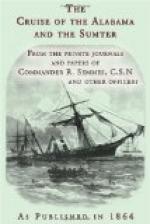After this melancholy recital, we walked across to get a little chat with the prisoner so recently captured. He is a superior man, and spoke of the loss of his ship in the spirit of a philosopher. He was leaning against a rail just opposite the cabin. “What can’t be cured must be endured,” said he. In answer to our remark, that an hour more would have saved him, he said, “Yes, it would; I had not the remotest idea of a capture at this end of the world. I never supposed that she was in this direction. I was in my cabin, washing,” said he, “and my mate came down and said there was a steamer in sight. ‘Capital!’ I said; ’it is the English mail-steamer; I shall be just in time for my letters.’ He went up again, and shortly returning, said, ‘She is going to hail us.’ ’Hail us!’ I said; ‘what the deuce can she want to hail us for?’ and I went on deck. I looked at that (pointing to the Confederate flag), and I soon saw who we were falling into the hands of. I said, ’Good-bye, mate; we shall not be long here.’ This, sir,” he went on to say, “is the second time I have been captured coming to the Cape. I left New York in the M.J. Calcon, and was captured by the Florida in 33 deg. West and between 28 deg. and 29 deg. North. I went home all right, and left New York again on the 28th of May, direct for the Cape.” This gentleman’s name is Mr. H. Spaling.
The next we had an opportunity of conversing with was the chief officer. This gentleman who, by the way, stands six feet four out of his shoes, showed us round the ship with just pride. He pointed out to us the peculiar qualities of the magnificent guns. One of Blakeley’s rifle pieces is a terrible-looking weapon. It throws conical shells of a hundred weight; and he remarked, “When we fought the Hatteras, these conical shells struck one after the other in capital style; they exploded with magnificent effect, and lit up her whole broadside.” Many of the captured crew we observed in irons.




